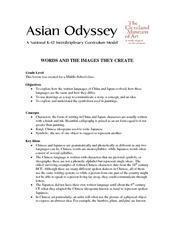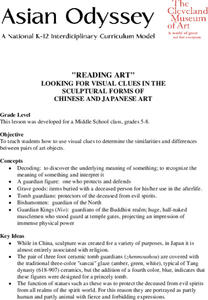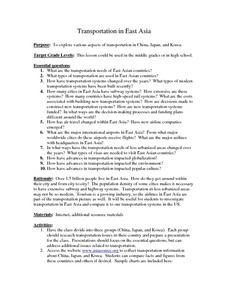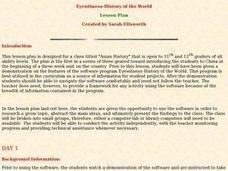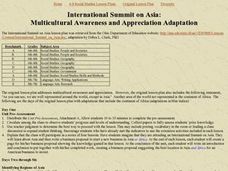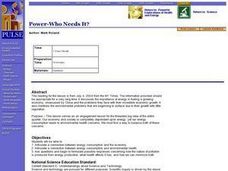Curated OER
Using Natural Resources In Chinese And Japanese Art
Students discuss the uses and availability of natural resources in China and Japan and how those resources effected visual art from each country. This lesson includes two possible enrichment activities.
Curated OER
The Language of Flowers And Trees
Students explore the symbolism of flowers and trees in Chinese and Japanese art. This lesson meets state standards and includes two possible lesson extensions or lesson enrichments.
Curated OER
"For The Birds" [part II]
Students examine how Chinese and Japanese artists used different kinds of birds
as representations of ideas that were important in both cultures and create their own birds using the technique of origami.
Curated OER
Natural Wonders of China And Japan
Pupils identify some of the attributes of China and Japan and compare and contrast the way Chinese, Japanese, and American artists represent nature in art. The lesson is for upper-elementary classrooms.
Curated OER
Religion And Magic
Students examine the indigenous religions of China (Daoism) and Japan (Shinto) to see how magical beliefs and practices form an integral part of these religions. This lesson may be controversial.
Curated OER
Words And the Images They Create
Students explore how the written languages of China and Japan evolved, creating representations of Chinese and Japanese Poetry. Emphasis is placed on small, cooperative learning groups.
Curated OER
Chado: The Way of Tea
Students participate in a tea ceremony in order to explore the multisensory experience that can be enjoyed as a bowl of tea and the various tea utensils are viewed, contemplated and experienced in this High School lesson.
Curated OER
Reading Art
Students compare and contrast different works of Asian sculptural forms and use visual clues to analyze those works. Evaluation for this lesson plan is done on the second class day with each student creating a drawing of an American...
Curated OER
The Four Religions of East Asia
Students compare and contrast the four main religions of Asia (Buddhism
Confucianism, Daoism, and Shinto). This lesson is intended for use in the middle school Social Studies classroom.
Curated OER
Tortured Beauty
Students compare and contrast two fundamentally different treatments of women, one Chinese and one Japanese, and to examine how this reflects on the culture that produced them.
Curated OER
The Silk Road
Students explore the Silk Road of Asia in this multi-day lesson plan that includes a "Silk Road roll play" and a mapping activity. This lesson plan can be used in a social studies or language arts classroom.
Curated OER
The Role of Monuments And Memorials
Learners investigate the use of monuments and memorials in various cultures in this three day Language Arts or Social Studies instructional activity. Emphasis is placed on in-class discussions, research, and individual creative projects.
Curated OER
"He Says, She Says"
Stuents compare and contrast male and female views of love and beauty in classic Chinese and Japanese society through the reading and evaluation of prose and poetry. Chinese and Japanese art is also studied.
Curated OER
Role of "Outsiders" And Traders in Society
Students examine the Chinese and Japanese conceptions of "insiders" and "outsiders" and how this affects the attitude toward foreign traders from the 6th to the 16th centuries. Lesson extensions are included.
Curated OER
Korea Lesson Plan
Sixth graders research the history and development of Korea as a culture and nation. This lesson plan is unique in that the focus is upon the neighboring countries of China and Japan in order to see their contributions to Korean society.
Curated OER
Asian Studies Unit Korea
Learners conduct research about different Asian countries. The research is done in order to compare and contrast the different land areas and cultures. Students complete a writing assessment related to it.
Curated OER
Korea Research
Young scholars investigate the details surrounding Korean Architecture. They look at some of the different styles and see how they may differ from some others found in the world. The research is done in order to appreciate the uniques...
Curated OER
Transportation in East Asia
Students engage in research about the subject of transportation in Eastern Asia. The size of countries and population pose challenges that are studied and reflected upon in student writings from the information found.
Curated OER
Eyewitness-History of the World
Young scholars, after given the opportunity to us the software Eyewitness-History of the World, research a given topic, abstract the main ideas, and ultimately present the findings to the class. Inevitably, the students design three quiz...
Curated OER
living in our family
Students compare a day in the life of a young person in one Asian country (India, Indonesia, Philippines, Thailand, or Vietnam) with a day in their own lives. The focus of this unit of work is on families, and students are required to...
Curated OER
International Summit on Asia
Young scholars conduct research into the continent and culture of Asia. The tapping of prior knowledge is done with a pre-unit assessment. The appreciation of Asian culture is the intended outcome of the unit plan.
Curated OER
Who Needs Power?
Students articulate the connection between energy consumption and the global economy. They identify and define the connection between energy consumption and environmental health. Students formulate suggestions concerning how the nature...
Curated OER
Our Family, Our Culture
Students understand that different cultures express themselves through music, dance, stories, and clothing. The class is divided into groups to research a country. They will gain a better understanding of how practices of groups are...
Curated OER
Learning About Asia
Students study about Asia from class lecture. They study about the continent, the main places in Asia, the products, the climate, and other important facts so they can write an outline for their paper. Students write their outline and...


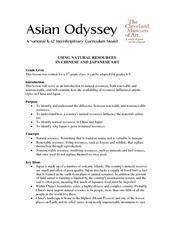
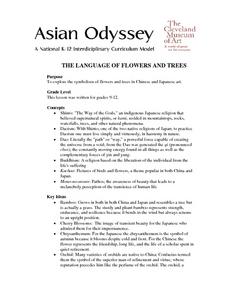
!["For The Birds" [part II] Lesson Plan "For The Birds" [part II] Lesson Plan](http://content.lessonplanet.com/resources/thumbnails/122476/large/cgrmlwnvbnzlcnqymdeymtaxny0yoda5lwu0ew85zi5qcgc.jpg?1414222640)


